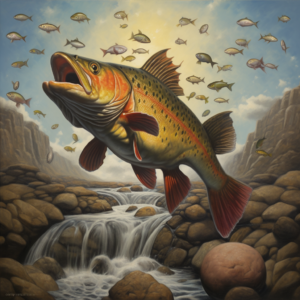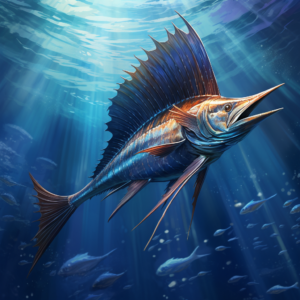Are you ready to embark on an adventure of a lifetime? Delve into the mysteries of the deep sea, where an entirely different world awaits you. Get ready to encounter the most magnificent marine life and test your skills as an angler. Welcome to the world of deep sea fishing!
The deep sea is a wondrous and mysterious place, filled with creatures that will leave you awe-inspired. With the vast expanse of the ocean below you, you will be immersed in a world that few have ever experienced.
Experience the thrill of deep-sea fishing and catch some of the most sought-after ocean inhabitants. From tuna and marlin to swordfish and sharks, the deep sea offers a fishing experience like no other. You’ll test your skills as an angler against unpredictable and powerful creatures, making this a challenge you won’t soon forget.
So, get ready to explore the depths of the ocean and discover the beauty and mystery that lies within. Deep-sea fishing is an adventure that you won’t want to miss!
Exploring the Depths: Underwater Exploration in the Deep Sea
Are you ready to dive into the abyssal zone and discover the mysteries hidden within the oceanic trenches? Underwater exploration in the deep sea is an adventure like no other, offering unparalleled opportunities to witness the incredible diversity of marine life and the unique landscapes of the abyssal zone.
The deep sea is the largest habitat on Earth, covering over 60% of our planet’s surface.
As you explore the depths, you’ll encounter breathtaking underwater mountains and valleys, as well as fascinating hydrothermal vents that create their own ecosystems. The abyssal zone also boasts a unique environment, with extreme conditions such as near-freezing temperatures and complete darkness. These conditions have forced deep-sea creatures to develop unique adaptations to survive.
Discovering the Oceanic Trenches
The oceanic trenches are some of the most mysterious and fascinating places in the deep sea. These underwater canyons are home to some of the deepest parts of the ocean, with depths reaching over 36,000 feet. Exploring the oceanic trenches offers a rare glimpse into the unknown, with the potential to discover new species and unique geological formations.
“The Mariana Trench is the deepest point on Earth, with a depth of over 36,000 feet.”
Unveiling the Abyssal Zone
The abyssal zone is the portion of the deep sea that lies between 13,000 and 20,000 feet deep. This region of the ocean is home to a vast array of fascinating creatures, from giant squid to bioluminescent organisms. The unique conditions of the abyssal zone have led to the evolution of remarkable adaptations in deep-sea creatures, such as bioluminescence and the ability to withstand extreme water pressure.
“Deep-sea creatures have developed unique adaptations, such as bioluminescence, to survive in the abyssal zone.”
Exploring the abyssal zone is a journey into the unknown, offering a rare opportunity to witness the incredible diversity of marine life that inhabits this fascinating environment.
Unveiling the Hidden: Deep-Sea Creatures and Marine Life
Prepare to be astounded by the incredible diversity of deep-sea creatures and marine life that inhabit the mysterious depths of the ocean. From towering giants of the deep to tiny bioluminescent organisms, the deep sea is teeming with life that has adapted to survive in an environment unlike any other.
At depths of over 3,000 feet, the pressure is extreme, the temperatures are freezing, and the sunlight is nonexistent. Yet, life finds a way. Explore the fascinating world of deep-sea creatures and marvel at their unique adaptations, from the flexible and translucent bodies of jellyfish to the sharp teeth and bioluminescent lures of anglerfish.
“The deep sea is really the final frontier on planet Earth. We know so little about it, and we have to protect it with the same passion and rigor as we do space exploration.” – Sylvia Earle
And it’s not just about the creatures themselves. The deep sea supports a complex network of ecosystems that are vital to the health and balance of our planet. From tiny plankton to massive whales, the deep sea plays a crucial role in the food web of the ocean.
However, this fragile ecosystem is under threat from human activities such as overfishing, pollution, and climate change. It’s important to remember that every action we take can have an impact on the deep sea and its inhabitants. Let’s work together to protect this incredible world of deep-sea creatures and marine life for future generations to enjoy.
From the Abyss to the Heavens: Hydrothermal Vents and Deep-Sea Mining
As you explore the depths of the oceanic trenches, you’ll come across hydrothermal vents. These vents release hot mineral-rich fluids, which create unique and complex ecosystems. They are home to a vast array of deep-sea creatures, from tube worms to eyeless shrimps.
“Hydrothermal vents are one of the most extreme environments on Earth, and the diversity of life found there is truly remarkable.”
Despite the incredible biodiversity of hydrothermal vents, they also present a valuable resource for deep-sea mining. The mineral-rich fluids can be harvested for their precious metals, such as gold and copper. However, the potential environmental impact of deep-sea mining remains uncertain and controversial.
“We must strike a balance between utilizing the resources of the deep sea and preserving its delicate ecosystems for future generations.”
From the Abyss to the Heavens: Hydrothermal Vents and Deep-Sea Mining
One of the biggest challenges of deep-sea mining is the lack of knowledge we have about the deep sea. The extreme conditions and the remoteness of the location make it difficult to study and understand the impact of mining activities.
In addition, the fragile ecosystems of the deep sea are highly vulnerable to disturbance. The damage caused by mining activities could have devastating impacts on the delicate balance of these ecosystems, potentially causing irreversible harm.
The Future of Deep-Sea Mining
The potential for deep-sea mining is significant, but so are the risks. It is crucial that we proceed with caution and develop sustainable practices that minimize the impact on the environment. As technology advances, we may be able to gain a better understanding of the deep sea and develop more effective conservation strategies.
As you explore the wonders of the deep sea, it is important to remember the importance of preservation and responsible resource use. By striking a balance between exploitation and conservation, we can continue to unlock the mysteries of the deep sea while ensuring the longevity of its fragile ecosystems.
Unraveling the Secrets: The Science of Oceanography
Behind every breathtaking deep sea expedition lies a robust scientific foundation rooted in oceanography. This field of study involves applying scientific principles and methods to understand the biological, physical, and chemical processes that shape the vast and complex oceanic system.
Oceanographers use various tools, such as satellites, underwater vehicles, and buoys, to explore and measure the ocean’s properties, including temperature, salinity, and currents. These measurements help create oceanographic models that predict the behavior of the oceans, such as how they circulate and mix.
One of the essential tasks of oceanography is mapping the ocean floor, a process that continues to reveal new and exciting discoveries about the deep sea. This process involves collecting data using remote sensing technologies, multibeam sonar systems, and underwater rovers to create detailed maps of the ocean floor.
Furthermore, oceanography plays a crucial role in understanding the impacts of climate change on marine ecosystems. By tracking changes in ocean temperature, acidity, and sea level, oceanographers can better predict how climate change will affect marine life and their habitats.
The Future of Oceanography
New technologies have revolutionized the field of oceanography, enabling scientists to study the deep sea in ways that were previously impossible. Robotic technologies, such as autonomous underwater vehicles, offer greater flexibility and can explore more remote areas of the ocean while reducing the risk to human divers.
Moreover, advancements in genetics and biotechnology are shedding light on the remarkable adaptations of deep-sea creatures and their medicinal properties. By studying the biological processes that enable deep-sea creatures to thrive in extreme conditions, scientists hope to discover new medicines and treatments.
In conclusion, the field of oceanography is vital in understanding and protecting the fragile ecosystem of the deep sea. By continuing to investigate and document the ocean’s properties, we can make informed decisions about the sustainable use of resources and mitigate the impacts of climate change on the marine environment.
Conclusion
Congratulations! You have completed your deep sea adventure and discovered the wonders of the abyss. As you reflect on your journey, you realize the importance of preserving this fragile ecosystem for future generations.
With its unique underwater landscapes and diverse marine life, the deep sea is a fascinating world waiting to be explored. It is up to us to protect it and ensure its conservation for years to come.
Whether you are an angler, marine biologist, or simply an adventurer at heart, the deep sea offers something for everyone. So why not plan your own expedition and experience this magical world for yourself?
Remember, the deep sea is not just a playground for humans. It is home to a variety of species, some of which are still undiscovered. Let us respect their habitat and continue to learn from the fascinating world of oceanography.
FAQ
Q: What is deep sea fishing?
A: Deep sea fishing refers to fishing activities that take place in the deeper parts of the ocean, typically beyond the continental shelf. It involves targeting larger, sport fish species such as marlin, tuna, and shark.
Q: Are there any safety precautions to consider when deep sea fishing?
A: Yes, safety is paramount when embarking on a deep sea fishing adventure. It is important to wear appropriate safety gear, listen to instructions from the crew, and be aware of any potential hazards or weather conditions. It is also advisable to have some basic swimming skills and knowledge of emergency procedures.
Q: Do I need any prior fishing experience to go deep sea fishing?
A: While prior fishing experience can be helpful, it is not necessary to have extensive knowledge or skills. Deep sea fishing charters often cater to both beginners and experienced anglers, providing guidance and assistance throughout the trip.
Q: What kind of fish can I expect to catch while deep sea fishing?
A: The types of fish you can catch while deep sea fishing vary depending on the location and time of year. Common species include marlin, tuna, mahi-mahi, snapper, and grouper. However, the deep sea is home to a wide range of fish species, making each trip a unique fishing experience.
Q: How long does a typical deep sea fishing trip last?
A: The duration of a deep sea fishing trip can vary. It can be as short as a few hours or as long as a full day or overnight adventure. Some charters even offer multi-day fishing excursions for those seeking a more extended deep sea fishing experience.




